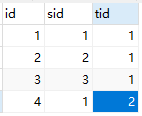SSM(二)MyBatis多表联查
这篇文章写了以下几个简单的例子,用来说明MyBatis多标联查基本语法
1.sql片段的用法
2.一对多查询
3.多条sql的一对多查询
4.多对一查询
5.多条sql一对多查询
6、多对多查询
这里沿着接口→小配置的路线写了,测试类就是遍历输出结果:
一、接口:
package cn.sohappy.acourses.course0921; import cn.sohappy.acourses.bean.BillManyToOne;
import cn.sohappy.acourses.bean.UserOneToMany;
import cn.sohappy.bean.Smbms_user; import java.util.List; public interface IUserDAO {
//01.sql片段,查询所有user
List<Smbms_user> findAll();
//02.oneToMany,传入user,返回包含账单信息的user
UserOneToMany getUserOneToManyBills(UserOneToMany user);
//03.oneToMany,多条sql查询,传入user,返回包含账单信息的user
UserOneToMany getUserOneToManyBillsMultiSQL(UserOneToMany user);
//04.manyToOne,传入bill,返回包含用户信息的bill
BillManyToOne getBillManyToOneUser(BillManyToOne bill);
//05.manyToOne,多条sql查询,传入bill,返回包含用户信息的bill
BillManyToOne getBillManyToOneUserMultiSQL(BillManyToOne bill);
}
二、小配置
先实现第一个方法
1、List<Smbms_user> findAll();查询所有user的编号,名字,密码
小配置的配置头
<?xml version="1.0" encoding="UTF-8" ?>
<!DOCTYPE mapper
PUBLIC "-//mybatis.org//DTD Mapper 3.0//EN"
"http://mybatis.org/dtd/mybatis-3-mapper.dtd">
<mapper namespace="cn.sohappy.acourses.course0921.IUserDAO">
<!--此处是代码-->
</mapper>
以下省略配置头
<sql id="columns">
userCode,userName,userPassword
</sql>
<resultMap id="mUser" type="cn.sohappy.bean.Smbms_user" autoMapping="false">
<id property="username" column="userName"/>
<result property="userpassword" column="userPassword"/>
<result property="usercode" column="userCode"/>
</resultMap>
<!--用<include refid="columns"/>代替*-->
<select id="findAll" resultMap="mUser">
select <include refid="columns"/> from smbms_user
</select>
2、UserOneToMany getUserOneToManyBills(UserOneToMany user);
查询某个用户的账单信息,首先将账单List植入用户类中(第11行)
package cn.sohappy.acourses.bean;
import java.util.List;
public class UserOneToMany {
private Long id;
private String usercode;
private String username;
//a user has lots of bills
private List<BillManyToOne> bills;
//getter and setter
}
小配置代码:
resultMap中property是对象的属性名,column是数据表中的字段名。collection是UserOneToMany对象中植入的泛型集合属性List<BillManyToOne> bills
语法是:<collection property="bills" ofType="cn.sohappy.acourses.bean.BillManyToOne">...code...</collection>
<!--.oneToMany-->
<resultMap id="UserOneToManyBills" type="cn.sohappy.acourses.bean.UserOneToMany" autoMapping="false">
<id property="id" column="u_id"/>
<result property="username" column="userName"/>
<collection property="bills" ofType="cn.sohappy.acourses.bean.BillManyToOne">
<id property="id" column="b_id"/>
<result property="productname" column="productName"/>
<result property="billcode" column="billCode"/>
</collection>
</resultMap>
<select id="getUserOneToManyBills" resultMap="UserOneToManyBills">
<!--不好,id重名了,起个别名吧-->
select smbms_user.id as u_id,userName,smbms_bill.id as b_id,productName,billCode from smbms_user,smbms_bill
where smbms_user.id=smbms_bill.createdBy and userCode=#{usercode}
</select>
3、UserOneToMany getUserOneToManyBillsMultiSQL(UserOneToMany user);
该方法通过多条sql查询user和其账单
小配置代码:其中#{**}是占位符
<!--.oneToMany多条sql-->
<resultMap id="UserOneToManyBillsMultiSQL" type="cn.sohappy.acourses.bean.UserOneToMany" autoMapping="false">
<id property="id" column="id"/>
<result property="username" column="userName"/>
<!--下行的select为第二条sql名,column为第一条sql的字段名,其唯一值作为第二条sql的条件-->
<collection property="bills" ofType="cn.sohappy.acourses.bean.BillManyToOne" select="selectBillsByUser" column="id"/>
</resultMap>
<select id="selectBillsByUser" resultType="cn.sohappy.acourses.bean.BillManyToOne">
select * from smbms_bill where createdBy=#{**}
</select>
<select id="getUserOneToManyBillsMultiSQL" resultMap="UserOneToManyBillsMultiSQL">
select * from smbms_user where userCode=#{usercode}
</select>
4、BillManyToOne getBillManyToOneUser(BillManyToOne bill);
传入bill,返回包含用户信息的bill,这里需要在bill类中植入user属性及相应getter and setter:private UserOneToMany user;
小配置代码:这里使用的语法是:<association property="user" javaType="cn.sohappy.acourses.bean.UserOneToMany">...code...</association>
<!--.manyToOne-->
<resultMap id="BillManyToOneUser" type="cn.sohappy.acourses.bean.BillManyToOne" autoMapping="false">
<id property="id" column="b_id"/>
<result property="billcode" column="billCode"/>
<association property="user" javaType="cn.sohappy.acourses.bean.UserOneToMany">
<id property="id" column="u_id"/>
<result property="usercode" column="userCode"/>
<result property="username" column="userName"/>
</association>
</resultMap>
<select id="getBillManyToOneUser" resultMap="BillManyToOneUser">
select smbms_user.id as u_id,userCode,userName,smbms_bill.id as b_id,billCode from smbms_user,smbms_bill
where smbms_user.id=smbms_bill.createdBy and billCode=#{billcode}
</select>
5.BillManyToOne getBillManyToOneUserMultiSQL(BillManyToOne bill);多条sql多对一查询
小配置代码:
<!--.manyToOne多条sql-->
<resultMap id="BillManyToOneUserMultiSQL" type="cn.sohappy.acourses.bean.BillManyToOne" autoMapping="false">
<id property="id" column="id"/>
<result property="billcode" column="billCode"/>
<association property="user" javaType="cn.sohappy.acourses.bean.UserOneToMany" autoMapping="false" select="selectUserByCreatedBy" column="CreatedBy">
<id property="id" column="id"/>
<result property="usercode" column="userCode"/>
<result property="username" column="userName"/>
</association>
</resultMap>
<select id="selectUserByCreatedBy" resultType="cn.sohappy.acourses.bean.UserOneToMany">
select * from smbms_user where id=#{**}
</select>
<!--这里需要查找公共字段createdBy作为association中的column参数-->
<select id="getBillManyToOneUserMultiSQL" resultMap="BillManyToOneUserMultiSQL">
select id,billCode,createdBy from smbms_bill where billCode=#{billcode}
</select>
最后写下多对多查询
其实多对多查询和一对多查询是一样的,只不过表中可能没有公共字段,要借助第三张表。
举个例子:根据老师id查询他所教授学生的id
下面建立三张表:
这是student表

这是老师表

这是第三张表

步骤和一对多是一样的,先生成实体类,然后在老师中植入学生List
创建接口,写个方法:
package cn.sohappy.acourses.course0923;
import cn.sohappy.acourses.bean.Teachert14;
public interface ITeacherDAO {
Teachert14 findStudentsByTeacher(Teachert14 teacher);
}
下面直接写小配置了:
<?xml version="1.0" encoding="UTF-8" ?>
<!DOCTYPE mapper
PUBLIC "-//mybatis.org//DTD Mapper 3.0//EN"
"http://mybatis.org/dtd/mybatis-3-mapper.dtd">
<mapper namespace="cn.sohappy.acourses.course0923.ITeacherDAO">
<resultMap id="mTeacher" type="cn.sohappy.acourses.bean.Teachert14">
<id property="tid" column="tid"/>
<result property="tname" column="tname"/>
<collection property="studentt14s" ofType="cn.sohappy.acourses.bean.Studentt14">
<id property="sid" column="sid"/>
<result property="sname" column="sname"/>
</collection>
</resultMap>
<select id="findStudentsByTeacher" resultMap="mTeacher">
select studentt14.sid,sname,teachert14.tid,tname from studentt14,teachert14,teacher_studentt14
where studentt14.sid=teacher_studentt14.sid and teachert14.tid=teacher_studentt14.tid
and teachert14.tid=#{tid}
</select>
</mapper>
最后附上测试类和MyBatis工具类:
测试类:
package cn.test; import cn.sohappy.acourses.bean.Studentt14;
import cn.sohappy.acourses.bean.Teachert14;
import cn.sohappy.acourses.course0923.ITeacherDAO;
import cn.sohappy.util.MyBatisUtil;
import org.apache.ibatis.session.SqlSession;
import org.junit.Test; public class test20170923 {
//多对多,借助第三张表
@Test
public void findStudentsByTeacher(){
SqlSession session = MyBatisUtil.getSession();
ITeacherDAO mapper = session.getMapper(ITeacherDAO.class);
Teachert14 teachert14 = new Teachert14();
teachert14.setTid(1L);
Teachert14 teacher = mapper.findStudentsByTeacher(teachert14);
for (Studentt14 item:teacher.getStudentt14s()) {
System.out.println(item.getSname());
}
}
}
MyBatis工具类:
package cn.sohappy.util; import org.apache.ibatis.io.Resources;
import org.apache.ibatis.session.SqlSession;
import org.apache.ibatis.session.SqlSessionFactory;
import org.apache.ibatis.session.SqlSessionFactoryBuilder; import java.io.IOException;
import java.io.InputStream; public class MyBatisUtil {
private static InputStream is;
private static SqlSessionFactory sqlSessionFactory;
static {
try {
is=Resources.getResourceAsStream("mybatis-config.xml");
} catch (IOException e) {
e.printStackTrace();
}
sqlSessionFactory= new SqlSessionFactoryBuilder().build(is);
}
private MyBatisUtil(){}
public static SqlSession getSession(){
return sqlSessionFactory.openSession();
}
}
最新文章
- [Python] python vs cplusplus
- 推荐几个精致的web UI框架
- Windows 7 安装.net framework 4.0 失败,错误HRESULT 0xc8000222解决办法
- Linux 高精確的時序(sleep, usleep,nanosleep) from:http://blog.sina.com.cn/s/blog_533ab41c0100htae.html
- 获取ip
- SQLite页缓冲区管理
- 主机找不到vmnet1和vmnet8
- Echarts-JAVA
- solr异常--Expected mime type application/octet-stream but got text/html.
- android listen
- Java z 404
- boost::asio实现一个echo服务器
- sdn测量论文简介
- Asp.Net 隐藏手机号中间四位为*方法
- Qt 事件机制
- 4.1.7 Cutting Game(POJ 2311)
- 【从0到1学Web前端】CSS伪类和伪元素 分类: HTML+CSS 2015-06-02 22:29 1065人阅读 评论(0) 收藏
- token的理解
- clojure中符号symbols 和变量vars的正确理解
- BZOJ3112 [Zjoi2013]防守战线 【单纯形】